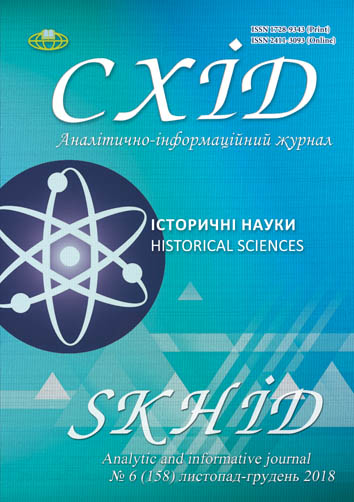15 years of the Baltic States membership in EU: problems, perspectives and experience for Ukraine
DOI:
https://doi.org/10.21847/1728-9343.2018.6(158).155047Keywords:
Baltic States, EU, results, membership, Ukraine, experienceAbstract
The article highlights the key provisions of the study of the results ofBaltic Statesmembership in the European Union. Analyzing the geopolitical dimension of European choice, the authors presented a brief discourse of the challenges that arose during the restoration of independence ofLatvia,LithuaniaandEstonia. The factors of the European choice of these countries, which consisted of security, economic and social dimensions, were considered.
The security factor of the European vector of politics was actualized in the desire of political elites to withdraw countries from the sphere of influence ofRussia. In the economic view, countries sought reorientation of economies to Western markets and incorporation into the architecture of trade relations of developed countries of the European Union.
It is noted that thanks to the Euro-Atlantic foreign policy vector and the strict fulfillment of the membership criteria, the Baltic States received access to preferential lending, assistance programs to candidate countries and managed to form one of the most attractive investment climate inEastern Europe.
Using key statistical indicators of the World Bank, Eurostat resource, analytical materials from leading audit company KPMG, key economic indicators are analyzed: GDP (in PPP) dynamics compared to other countries of Central and Eastern Europe, wages and retirement benefits. The consideration of economic gains from EU membership is complemented by an analysis of the structure of GDP and the study of the industry specification.
The losses from the process of European integration, which consisted of: significant reduction of industrial production, unprofitability of agriculture, emigration of the population aged 25 to 35 years, were also identified.
The attitude of residents to EU membership has been studied using the results of the annual surveys of the European service "Eurobarometer". It was found that in 2018, the positive attitude of residents ofLatvia,LithuaniaandEstoniadid not actually change compared to 2004. The charts available in the article also allow us to determine that the level of euroskepticism in the countries in question has not significantly changed compared to the first year of membership in the EU.
The authors propose algorithms for taking Ukraine into account the experience of the Baltic States on the path to full membership.94(4)+ (442)63-6Downloads
References
Bilonozhko, S. V., 2015. Western vector of the foreign policy of the Baltic countries: the path from independence to Eurointegration. Scientific works of the Historical Faculty of Zaporizhzhya National University. Vol. 44: 130-135 (ukr).
Vorotnikov, V. V., 2014. Baltic countries in NATO: the results of the decade. Herald of MGIMO-University. № 6: 9-17 (rus).
Zavadsky, V. М., 2008. European Integration of theBaltic States(1991-2004). These of Candidate of historical Science.Donetsk, 2008. 225 p. (ukr).
Kokoriev, O. V., 2016. Positive and negative consequences of transformation in the Baltic States and accession to the EU. Bulletin of Donetsk National University, Series: Political Sciences: 68-71 (ukr).
Pali, O. A. 2002. Specificity and implications of the integration of the Baltic Statesinto Euro-Atlantic security structures. Scientific notes of NaUKMA. Vol. 20: 55-60 (ukr).
Accrued-to-date pension entitlements in social insurance. Available at: http://appsso.eurostat.ec.europa.eu/nui/show.do?dataset=nasa_10_pens1&lang=en (Accessed: 18.11.2018).
Agenda 2000, Communication: Reinforcing the pre-accession strategy. Brussels: European Commission, 1997. 120 p.
Investment in the Baltic States - KPMG - Global. Available at: https://www.kpmg.de/docs/InvestmentBalticSeas.pdf (Accessed: 21.12.2018).
Pastore, G. 2011. Europeanization of Foreign Policy of the New Member States: The Case of Latvia. А collection of research papers in conjunction with the international conference “European Integration and Baltic Sea Region: Diversity and Perspectives”, 26-27 September 2011 at the University of Latvia. Litvia. Riga: 59-70.
The World Factbook. Available at: https://www.cia.gov/library/publications/the-world-factbook/fields/214.html#LH (Accessed: 21.12.2018).
Total number of long-term emigrants leaving from the reporting country during the reference year. Available at: https://ec.europa.eu/eurostat/tgm/table.do?tab=table&init=1&language=en&pcode=tps00177&plugin=1 (Accessed: 18.11.2018).
Wage and salaried workers. Available at: https://data.worldbank.org/indicator/ SL.EMP.WORK.MA.ZS?end=2017&start=1991&view=chart (Accessed: 21.12.2018).
Downloads
Published
How to Cite
Issue
Section
License
Copyright (c) 2019 Lukash Donaj, Vitaliy Zavadskyi

This work is licensed under a Creative Commons Attribution-NonCommercial-NoDerivatives 4.0 International License.
1. Authors bear responsibility for the accuracy of facts, quotations, numbers and names used.
2. Manuscripts are not sent back.
3. The publisher does not always agree with the authors' opinion.
4. The authors reserve the right to authorship of the work and pass the first publication right of this work to the journal under the terms of a Creative Commons Attribution-NonCommercial-NoDerivatives 4.0 International License. This license allows others to distribute (copy) the published work for non-commercial purposes, provided there is mandatory attribution to its authors and a link to the first publication in our journal.
5. The authors have the right to conclude separate supplement agreements that relate to non-exclusive work distribution in the form in which it has been published by the journal (for example, to upload the work to the online storage of the journal or publish it as part of a monograph), provided that the reference to the first publication of the work in this journal is included.

